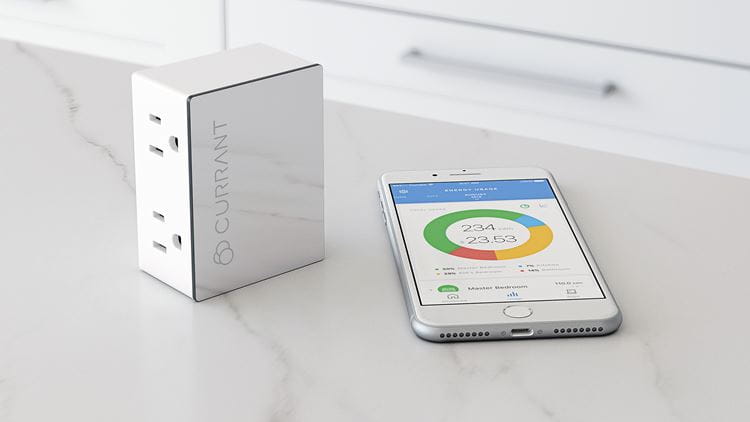Smart home
Low power wireless connectivity solutions for smart home

Nordic Semiconductor today announces that Califronia-based smart home solutions company, Currant, has selected Nordic’s nRF52832 System-on-Chip (SoC) to provide the Bluetooth® Low Energy (Bluetooth LE) wireless connectivity for its ‘WiFi Smart Outlet’, a Bluetooth LE- and Wi-Fi-connected device employing artificial intelligence (AI) to enable users to monitor and manage their power usage, reduce energy consumption, and cut electricity costs.
In operation the user can plug any household appliance into the WiFi Smart Outlet, which in turn is plugged into any power outlet in the home. Once paired with a Bluetooth 4.0 (and later)-enabled smartphone or tablet using Bluetooth LE wireless connectivity provided by the Nordic SoC—or via a Wi-Fi connection—the user can immediately review their energy usage and costs by appliance, as well as create customized rules to manage their energy usage, via the iOS or Android ‘Currant app’. For example, the app can be used to switch on and off an appliance in a particular room at predetermined times. Wi-Fi connectivity enables the smart outlet to be monitored and controlled remotely via the Cloud when the user is away from home. At home, the user can use voice control to instruct Amazon Alexa or Google Home to operate a connected appliance.
The WiFi Smart Outlet uses AI to recognize patterns in energy usage and suggest changes to cut down on electricity costs. Once the device has been in operation for approximately one week it will learn the user’s schedule, the devices that are plugged in, and the associated energy usage. Using this information—and data gathered from thousands of other devices—the Currant app will recommend a schedule for everything the user has connected to minimize energy consumption and reduce costs. The user has control over whether to accept the schedule or change it, which in turn enables Currant’s proprietary algorithm to continue to learn and improve over time.
In addition to providing Bluetooth LE connectivity, the Nordic SoC functions as the device’s CPU, the nRF52832’s powerful 64MHz, 32-bit Arm® Cortex™ M4F processor provides ample computational power, Digital Signal Processing (DSP), and Floating-Point (FP) arithmetic functionality to both run the Bluetooth LE RF protocol software (‘stack’) and assist the application software’s complex AI algorithms.

Nordic’s nRF52832 SoC is a powerful multiprotocol SoC ideally suited for Bluetooth LE and 2.4GHz ultra low-power wireless applications. The nRF52832 combines an 64MHz, 32-bit Arm Cortex M4F processor with a 2.4GHz multiprotocol radio (supporting Bluetooth 5, ANT™, and proprietary 2.4GHz RF software) featuring -96dB RX sensitivity, with 512kB Flash memory and 64kB RAM.
The SoC is supplied with Nordic’s S132 SoftDevice, a Bluetooth 5-certifed RF software protocol stack for building advanced Bluetooth LE applications. The S132 SoftDevice features Central, Peripheral, Broadcaster, and Observer Bluetooth LE roles, supports up to twenty connections, and enables concurrent role operation. Nordic's unique software architecture provides clear separation between the RF protocol software and the developer's application code, easing product development.
“Aside from the Nordic SoC’s small package size and attractive price, its Arm Cortex M4F processor made our decision to use the nRF52832 SoC easy,” says Hasty Granbery, CEO, Currant. “The energy monitoring chip in the smart outlet delivers data at an extremely high rate and the nRF52832 SoC’s FP unit allows much of the computation to be handled directly by the Nordic SoC, reducing the amount of raw data needing to be sent over the radio.”
“Nordic was willing to provide deep technical support for a chip-down design to an emerging company like Currant making the solution more cost-effective than purchasing a module. The separation of SoftDevice and application code, along with Nordic’s supporting documentation, Software Development Kit, and Nordic DevZone customer support portal eased development, while its early embrace of the Bluetooth mesh specification gave us a solid platform to build robust and fault-tolerant networking into our product,” adds Granbery.
Low power wireless connectivity solutions for smart home